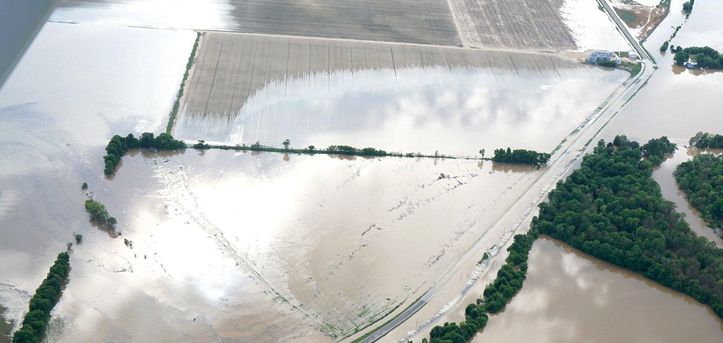Flood conditions imperil thousands of cropland acres in the Delta
by June 10, 2019 9:11 am 964 views

The Mississippi River basin continues to swell and those flood water levels are leaving surrounding fields soaked and unable to be worked, leaving farmers months behind and losing money, said Robert Goodson, Phillips County extension agent for the University of Arkansas System Division of Agriculture. As many as 40,000 crop acres in the Delta could be directly impacted by the floods. The region has been affected since April, Goodson said.
The high water is more than just the Mississippi leaving its banks. The river water is soaking through the soil that makes up Arkansas’ Delta growing region, penetrating the Mississippi River Valley alluvial aquifer that underlays parts of eastern Arkansas, southeast Missouri, northeastern Louisiana, western Tennessee and western Mississippi.
The water source has been critical for Arkansas agriculture. In 2000, an estimated 34 billion liters of water a day was withdrawn from the aquifer, according to estimates. Farmers have relied on it for decades to provide irrigation — giving water when the pumps go one.
Since the Mississippi River has been flooding, Goodson and others have found, that water is coming up those pumps unbidden, as the Mississippi River waters put pressure on underground supplies. The water has to go somewhere, and the holes punched through the soil for the wells provides an easy outlet.
This “seep water” comes up through the ground when the Mississippi River is high, and it will not drain because there is no place for it to go, Goodson said. Around 20,000 to 40,000 acres are affected, he said. The areas affected are on the left side of the levee, on the east side of Phillips County.
“The larger volume of water increases the height of the water in the river,” Jeannie Barlow, assistant director for water availability and use studies at the U.S. Geological Survey Lower Mississippi-Gulf Water Science Center said. “As that height goes up, we see the river levels go up, and it is moving steadily into the aquifer.”
Water flows downhill and the river level is higher than the aquifer, meaning the water has to go somewhere, Barlow said.
“It gets tricky. The water goes to different places.” Barlow said. “Some of the water goes into bank storage, where you see the seep water occur.”
It’s fairly common in areas where the soil along the bank is more prone to seepage, said James Pogue, a spokesman for the Memphis District of the U.S. Army Corps of Engineers.
The increased water levels also have the potential to create sand boils, where the water pressure boils up to the surface in a pool of sand and water. With the river levels going down, the boils are not likely, Goodson said.
“The water most definitely puts farmers behind. For some it is almost as much as two months,” Goodson said. “All they can do is wait for the river to go down.”
Prevented planting insurance claims may be an option for farmers who are not able to get into their fields, Goodson said.
“We don’t fully understand what the impact of this flooding will be yet, the effects differ from place to place,” Barlow said.
The Mississippi River at Helena is predicted to crest Thursday (June 13) at 40.5 feet, above the 40-foot flood stage, according to the National Weather Service.
